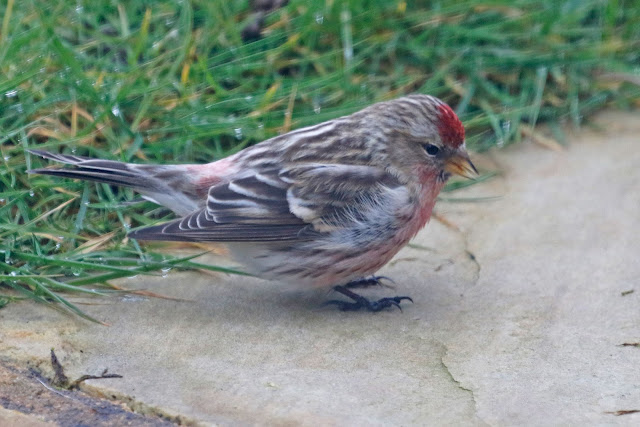As I passed through the kitchen this morning I looked out to the feeders as I always seem to do, and saw a Starling feeding on the patio, but just to the right of it was a very pale and pink bird that I immediately recognised as a Redpoll, but also realised that it was not like the Lesser Redpolls of which there have been up to four in the garden. It was much paler and appeared larger than the Lesser Redpolls. I immediately ran upstairs to get my camera, praying that it would still be there when I came down. It was still about
The taxonomy of Redpolls is difficult and unsettled, with
several different very closely related forms of Redpolls which have been
considered as anything from one to five species although some studies favour distinct
three species
The species are:
Arctic Redpoll (Acanthis hornemanni)
- · h. hornemanni (Greenland Arctic Redpoll)
- · h. exilipes (hoary Redpoll)
Common Redpoll (Acanthis flammea)
- · f. flammea (mealy Redpoll)
- · f. islandica (Icelandic Redpoll)
- · f. rostrata (Greenland Redpoll)
Lesser Redpoll (Acanthis cabaret)
But this is certainly not definite. Global lists currently
support either two species (Common and Arctic Redpoll) or a single species
(Common Redpoll). Most recently, genomewide analyses found differences
in gene expression but no genetic divergence, suggesting that plumage
forms have originated recently, within a single interbreeding lineage, and do
not represent species boundaries to separate them.
So what did I have in the garden, from the pictures and behaviour was this a Mealy Redpoll, or Common Redpoll Acanthis Flammea Flammea? Interestingly the genus name comes from the Greek Akanthis a name for a now unidentifiable bird.
The bird was much paler than the Lesser Redpolls with the upper parts being greyish white, and lacking any buff colour, while the underparts were paler, and where there was streaking this was well defined.
From the rich pink flush on the breast and forehead this was a male. The bill was yellowish with a fine conical shape.
It moved over the patio with a slow creeping style very reminiscent of a feeding Snow Bunting, searching for, and finding seeds under the grass that met the edge of the slabs.
The rump was also distinctive, at first I thought it was a pale white, but I could see as it crept away from me that it was in fact pink.
As it crept away from me, I moved to the next window where I could view it head on as it worked along the edge of the grass.
Another feature that stood it out from the Lesser Redpolls were the flared white feathers from the sides over the coverts.
Here you can see the shape of the bill, and pale underparts and the defined large streaks
But this behaviour was strange, it appeared to be trying to swallow
The Helm Guide to Bird Identification refers to two whitish tramlines down the back, and in this view these are clearly visible.
Looking back through Hampshire bird reports the last reported Common or Mealy Redpoll was in 2014, there was a single report from Crookham Village on the 10th March.
Here though it has buff brown coloured sides to the head, in the Mealy this should be lighter and more grey.
When I reported it I was not 100% certain, I read up on the identification and reviewing the photographs I was still not 100% certain. Also the problems with swallowing was not a good sign In comparison here is one of the Lesser Redpolls, and you can see the similarity with the head colour and markings.
The Mealy stayed for about 15 minutes, and did not return when I was looking through the day.
On Saturday I saw it again and there were more pointers to Lesser Redpoll, in fact I think the bird is diseased, and has trichonomosis, while it doesn't stay when I approach it is very lethargic, and constantly throws the head back as if trying to swallow. The Goldfinches I have seen diseased seem to plump up and look bigger, and unfortunately everything points to this with this Redpoll. Time to clean and bring in the feeders!
On Saturday I saw it again and there were more pointers to Lesser Redpoll, in fact I think the bird is diseased, and has trichonomosis, while it doesn't stay when I approach it is very lethargic, and constantly throws the head back as if trying to swallow. The Goldfinches I have seen diseased seem to plump up and look bigger, and unfortunately everything points to this with this Redpoll. Time to clean and bring in the feeders!














No comments:
Post a Comment
Note: only a member of this blog may post a comment.